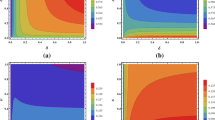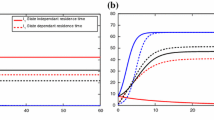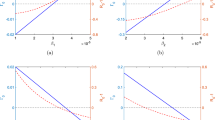Abstract
How do spatial heterogeneity, habitat connectivity, and different movement rates among subpopulations combine to influence the observed spatial patterns of an infectious disease? To find out, we formulated and analyzed a discrete-time SIS patch model. Patch differences in local disease transmission and recovery rates characterize whether patches are low-risk or high-risk, and these differences collectively determine whether the spatial domain, or habitat, is low-risk or high-risk. In low-risk habitats, the disease persists only when the mobility of infected individuals lies below some threshold value, but for high-risk habitats, the disease always persists. When the disease does persist, then there exists an endemic equilibrium (EE) which is unique and positive everywhere. This EE tends to a spatially inhomogeneous disease-free equilibrium (DFE) as the mobility of susceptible individuals tends to zero. The limiting DFE is nonempty on all low-risk patches and it is empty on at least one high-risk patch. Sufficient conditions for the limiting DFE to be empty on other high-risk patches are given in terms of disease transmission and recovery rates, habitat connectivity, and the infected movement rate. These conditions are also illustrated using numerical examples.
Similar content being viewed by others
References
Allen L.J.S., Bolker B.M., Lou Y., Nevai A.L.: Asymptotic profile of the steady states for an SIS epidemic patch model. SIAM J. Appl. Math. 67, 1283–1309 (2007)
Allen L.J.S., Bolker B.M., Lou Y., Nevai A.L.: Asymptotic profile of the steady states for an SIS epidemic reaction-diffusion model. Discr. Cont. Dyn. Sys. A. 21, 1–20 (2008)
Allen L.J.S., Burgin A.: Comparison of deterministic and stochastic SIS and SIR models in discrete time. Math. Biosci. 163, 1–33 (2000)
Allen L.J.S., Jones M.A., Martin C.F.: A discrete-time model with vaccination for a measles epidemic. Math. Biosci. 105, 111–131 (1991)
Allen L.J.S., Kirupaharan N., Wilson S.M.: SIS epidemic models with multiple pathogen strains. J. Differ. Equ. Appl. 10, 53–75 (2004)
Allen, L.J.S., van den Driessche, P.: The basic reproduction number in some discrete-time epidemic models. J. Differ. Equ. Appl. (2008) (in press)
Arino J., Jordan R., van den Driessche P.: Quarantine in a multi-species epidemic model with spatial dynamics. Math. Biosci. 206, 46–60 (2007)
Caraco T., Duryea M., Gardner G., Maniatty W., Szymanski B.K.: Host spatial heterogeneity and extinction of an SIS epidemic. J. Theor. Biol. 192, 351–361 (1998)
Carrillo C., Fife P.: Spatial effects in discrete generation population models. J. Math. Biol. 50, 161–188 (2005)
Castillo-Chavez C., Yakubu A.-A.: Dispersal, disease and life-history evolution. Math. Biosci. 173, 35–53 (2001)
Castillo-Chavez C., Yakubu A.-A.: Intraspecific competition, dispersal, and disease dynamics in discrete-time patchy environments. In: Castillo-Chavez, C., Blower, S., Driessche, P., Kirschner, D., Yakubu, A.-A. (eds) Mathematical Approaches for Emerging and Reemerging Infectious Diseases An Introduction, pp. 165–181. Springer, New York (2002)
Cushing, J.M.: An Introduction to Structured Population Dynamics. CBMS-NSF Regional Conference Series in Applied Mathematics. SIAM, PA (1998)
Cushing J.M., Yicang Z.: The net reproductive value and stability in structured population models. Nat. Resour. Model. 8, 1–37 (1994)
de Jong M.C.M., Diekmann O., Heesterbeek J.A.P.: The computation of R 0 for discrete-time epidemic models with dynamic heterogeneity. Math. Biosci. 119, 97–114 (1994)
Dhirasakdanon T., Thieme H., van den Driessche P.: A sharp threshold for disease persistence in host metapopulations. J. Biol. Dyn. 1, 363–378 (2007)
Diekmann O., Heesterbeek J.A.P.: Mathematical Epidemiology of Infectious Diseases. Wiley, Chichester (2000)
Diekmann O., Heesterbeek J.A.P., Metz J.A.J.: On the definition and the computation of the basic reproduction ratio \({\mathcal R_0}\) in models for infectious diseases in heterogeneous populations. J. Math. Biol. 28, 365–382 (1990)
Doebeli M., Ruxton G.D.: Stabilization through pattern formation in metapopulations with long-range dispersal. Proc. R. Soc. Lond. B. 265, 1325–1332 (1998)
Emmert K.E., Allen L.J.S.: Population persistence and extinction in a discrete-time, stage-structured epidemic model. J. Differ. Equ. Appl. 10, 1177–1199 (2004)
Gantmacher F.R.: The Theory of Matrices, vol. II. Chelsea, New York (1960)
Hsieh Y.-H., van den Driessche P., Wang L.: Impact of travel between patches for spatial spread of disease. Bull. Math. Biol. 69, 1355–1375 (2007)
Lewis M.A., Rencławowicz J., van den Driessche P.: Traveling waves and spread rates for a West Nile virus model. Bull. Math. Biol. 68, 3–23 (2006)
Lewis M.A., Rencławowicz J., van den Driessche P., Wonham M.: A comparison of continuous and discrete-time West Nile Virus models. Bull. Math. Biol. 68, 491–509 (2006)
Li C.-K., Schneider H.: Applications of Perron-Frobenius theory to population dynamics. J. Math. Biol. 44, 450–462 (2002)
Medlock J., Kot M.: Spreading disease: integro-differential equations old and new. Math. Biosci. 184, 201–222 (2003)
Ortega J.M.: Matrix Theory: A Second Course. Plenum Press, New York (1987)
Postnikov E.B., Sokolov I.M.: Continuum description of a contact infection spread in a SIR model. Math. Biosci. 208, 205–215 (2007)
Ruan S.: Spatial–temporal dynamics in nonlocal epidemiological models. In: Takeuchi, Y., Sato, K., Iwasa, Y. (eds) Mathematics for Life Science and Medicine, vol 2, pp. 97–122. Springer, New York (2007)
Smith, H.: Monotone Dynamical Systems, An introduction to the theory of competitive and cooperative systems. American Mathematical Society, Mathematical Surveys and Monographs (1995)
van den Driessche P., Watmough J.: Reproduction numbers and sub-threshold endemic equilibria for compartmental models of disease transmission. Math. Biosci. 180, 29–48 (2002)
Wang M.-H., Kot M., Neubert M.G.: Integrodifference equations, Allee effects, and invasions. J. Math. Biol. 44, 150–168 (2002)
Yakubu A.-A., Castillo-Chavez C.: Interplay between local dynamics and dispersal in discrete-time metapopulation models. J. Theor. Biol. 218, 273–288 (2002)
Author information
Authors and Affiliations
Corresponding author
Rights and permissions
About this article
Cite this article
Allen, L.J.S., Lou, Y. & Nevai, A.L. Spatial patterns in a discrete-time SIS patch model. J. Math. Biol. 58, 339–375 (2009). https://doi.org/10.1007/s00285-008-0194-y
Received:
Published:
Issue Date:
DOI: https://doi.org/10.1007/s00285-008-0194-y
Keywords
- Spatial heterogeneity
- Dispersal
- Habitat connectivity
- Basic reproduction number
- Disease-free equilibrium
- Endemic equilibrium




